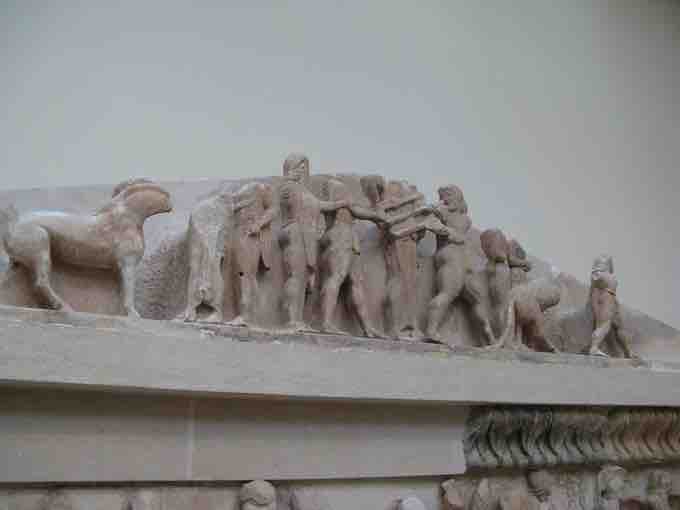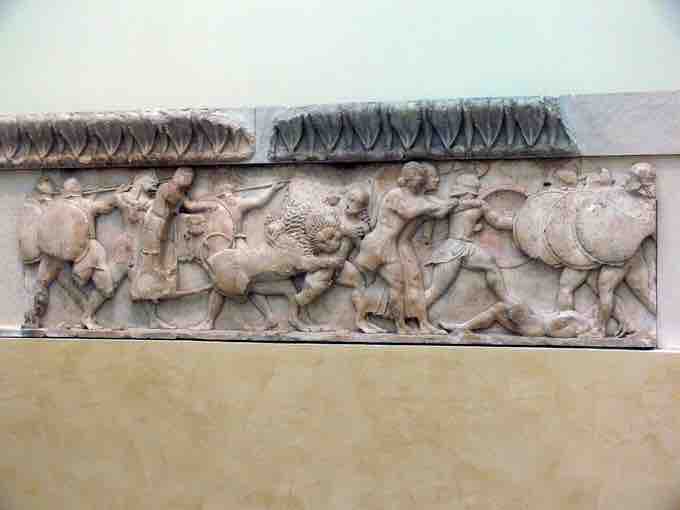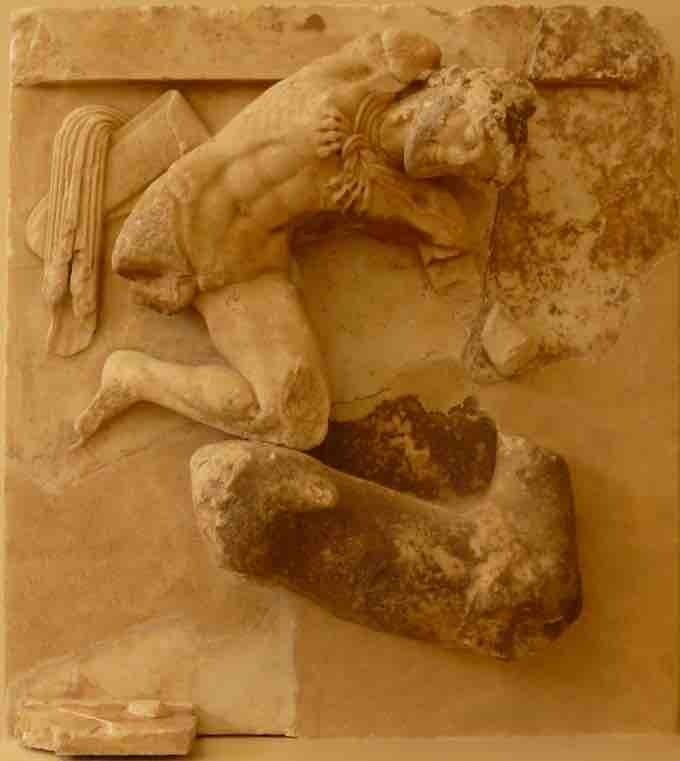Delphi
The ancient site of Delphi, located in central Greece on the slope of Mt. Parnassus, was known for its Sanctuary of Apollo, the Delphic Oracle, and the Pythian Games. Delphi was home to the dragon Python who protected the navel of the earth. Apollo slew the Python, establishing his presence at the site. The panhellenic Pythian games held every four years, along with musical compositions, commemorate Apollo's victory over the beast.
Not only was the site the main place of worship for the god Apollo but it also was the home of an oracle. The oracle was a sibyl or priestess known as a Pythia. According to myth, when Apollo slew the Python, the creature's body fell into a fissure and began decomposing. The oracle would place her tripod seat over the fissure, inhale the fumes, and then would be possessed by Apollo, allowing him to speak through her. The Delphic Oracle was an essential part of Greek life and was consulted for matters public and private, small and large and so had commanding power over the lives of the Greeks. The oracle's prophecies were usually unintelligible and would be translated into poetic meter by priests.
Temple of Apollo
The site of Delphi is dominated by a central Temple of Apollo, a fourth-century BCE replacement of the Archaic sixth-century temple. One peristyle of Doric columns (the order used in Archaic architecture) surrounded the perimeter of the stylobate, which rested atop two steps. Inside the Temple of Apollo was the seat of the Pythia, in a small restricted room in the back of the naos, known as an adyton, which translates to English as "not to be entered."
Temple of Apollo
Reconstructed Doric columns mark the east end (front) of the temple.
There was also a large theatre built into the hillside located just above the Temple of Apollo. The theatre was first built in the fourth century BCE and renovated multiple times in the following centuries. It could seat 5,000 spectators and offered a view of the entire sanctuary site and the valley.
Treasuries
The road leading up to the sanctuary site of Apollo was lined with votive statues and treasuries. The treasuries were built by different poleis to honor the oracle, thank her for her advice, and commemorate military victories. These small, temple-like structures held the votives and offerings made to Apollo as well as a small proportion of the spoils won from battle from each polis. Because the buildings held a wealth of materials and goods, they are known as treasuries. These buildings were single-room naosoi (plural of naos) fronted by two columns in antis and decorated in either the Doric or Ionic style.
Siphnian Treasury
The Siphnian Treasury was built for the polis of Siphnos, a city-state that occupied a Cycladic island. The Siphnians had large gold and silver mines, from which they profited enormously, and they used the profits to erect their treasury at Delphi. The treasury housed their gold and silver gifts to the gods. The Siphian Treasury was the first structure built entirely from marble when it was erected in 530 BCE and was elaborately decorated.
The two columns in antis were not typical columns but caryatids, supportive columns that took the shape of women. A continuous Ionic frieze that wrapped around the top of the treasury beneath the pediment depicted scenes from Greek mythology, including a gigantomachy on the north side, the Judgment of Paris on the west side, and gods watching the sack of Troy by the Greeks on the south and east sides. The east pediment recounts the story of Herakles stealing Apollo's tripod, which visually connects the pediment and the treasury to the oracle site at the Temple of Apollo.

Herakles and Apollo
Herakles stealing the tripod of Apollo. From the east pediment of the Siphnian Treasury. Marble. c. 530 BCE. Siphnian Treasury, Delphi, Greece.

Gigantomachy
A gigantomachy scene from the north frieze of the Siphnian Treasury. Marble. c. 530 BCE. Siphnian Treasury, Delphi, Greece.
The figures are carved in an Archaic style and in high relief, and they are almost, but not entirely, freed from the wall of the frieze. While the figures appear to be in motion, with wide stances and arms open wide for battle, the majority of them stand with both feet flat on ground. This inhibits the sense of motion given by the rest of their bodies. The pedimental figures are especially rigid and linear, although the figures are no longer scaled to fit into the small corners of the pediment. When looking at these figures, from the front they appear to appropriately model the body, while from the side the figures appear block-like, emphasizing the fact that they were carved from stone.
Athenian Treasury
The Athenian treasury at Delphi was built between 510 and 480 BCE to commemorate the Athenian victory over the Persians during the Battle of Marathon. Like the Siphnian Treasury, the Athenian Treasury was constructed entirely of marble. The treasury has Doric columns and a frieze of triglyphs and thirty metopes that depict scenes from the life of Theseus, an Athenian mythological hero, and Herakles. The metopes also display the development of Archaic relief and temple decoration. The figures do not feel forced into their frame but instead begin to fill out the scene. Most of the scenes consist of only two characters and few scenes, such as Herakles fighting the Ceryean Hind (an enormous deer), and display a new sense of ingenuity. The figure of Herakles breaks out of the frame as he leans on the hind's back, trying to catch it. Furthermore, the figures, unlike those on the Siphnian pediment, appear modeled from all sides, as opposed to just frontally.

Herakles and Ceryean Hind
Metope depicting Herakles and Ceryean Hind. Marble. c. 510-480 BCE. Treasury of Athens, Delphi, Greece

Athenian Treasury
Athenian Treasury. Marble. c. 510-490 BCE. Delphi, Greece.